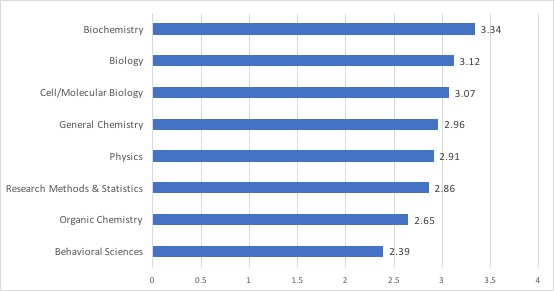|
National Medical Admission Test (Philippines)
The National Medical Admission Test (NMAT) is a nationwide examination required for the entrance to any medical school in the Philippines. It is sometimes considered as equivalent to the MCAT, which is held in the United States. The test consists of Part I and Part II. Part I is a 200-item test with four subdivisions, which are on Verbal, Inductive Reasoning, Quantitative and Perceptual Acuity Skills and is a three-hour exam. Part II is a two-hour-30-minute test in the field of basic sciences such as Biology, Physics, Social Sciences and Chemistry, all of which form 200 items. Qualified test takers are graduates and graduating students of degree programs. So that is 5 hours and 30 minutes exam in a day. Generally its results come in about 15 working days, and a candidate can get the admission as per college requirements. The grading system is percentile ranking from 1- to 99+ and marks are given ranging from 200 to 800. See also * List of medical schools in the Philippines *Medical ... [...More Info...] [...Related Items...] OR: [Wikipedia] [Google] [Baidu] |
Medical School
A medical school is a tertiary educational institution, professional school, or forms a part of such an institution, that teaches medicine, and awards a professional degree for physicians. Such medical degrees include the Bachelor of Medicine, Bachelor of Surgery (MBBS, MBChB, MBBCh, BMBS), Master of Medicine (MM, MMed), Doctor of Medicine (MD), or Doctor of Osteopathic Medicine (DO). Many medical schools offer additional degrees, such as a Doctor of Philosophy (PhD), master's degree (MSc) or other post-secondary education. Medical schools can also carry out medical research and operate teaching hospitals. Around the world, criteria, structure, teaching methodology, and nature of medical programs offered at medical schools vary considerably. Medical schools are often highly competitive, using Standardized test, standardized entrance examinations, as well as Grading in education, grade point averages and leadership roles, to narrow the selection criteria for candidates. In most c ... [...More Info...] [...Related Items...] OR: [Wikipedia] [Google] [Baidu] |
Philippines
The Philippines, officially the Republic of the Philippines, is an Archipelagic state, archipelagic country in Southeast Asia. Located in the western Pacific Ocean, it consists of List of islands of the Philippines, 7,641 islands, with a total area of roughly 300,000 square kilometers, which are broadly categorized in Island groups of the Philippines, three main geographical divisions from north to south: Luzon, Visayas, and Mindanao. With a population of over 110 million, it is the world's List of countries and dependencies by population, twelfth-most-populous country. The Philippines is bounded by the South China Sea to the west, the Philippine Sea to the east, and the Celebes Sea to the south. It shares maritime borders with Taiwan to the north, Japan to the northeast, Palau to the east and southeast, Indonesia to the south, Malaysia to the southwest, Vietnam to the west, and China to the northwest. It has Ethnic groups in the Philippines, diverse ethnicities and Culture o ... [...More Info...] [...Related Items...] OR: [Wikipedia] [Google] [Baidu] |
MCAT
The Medical College Admission Test (MCAT; ) is a computer-based standardized examination for prospective medical students in the United States, Canada, Australia, and the Caribbean Islands. It is designed to assess problem solving, critical thinking, written analysis and knowledge of scientific concepts and principles. Before 2007, the exam was a paper-and-pencil test; since 2007, all administrations of the exam have been computer-based. The most recent version of the exam was introduced in April 2015 and takes approximately hours to complete, including breaks. The test is scored in a range from 472 to 528. The MCAT is administered by the Association of American Medical Colleges (AAMC). History Moss Test: 1928–1946 In the 1920s, dropout rates in US medical schools soared from 5% to 50%, leading to the development of a test that would measure readiness for medical school. Physician F. A. Moss and his colleagues developed the "Scholastic Aptitude Test for Medical Stu ... [...More Info...] [...Related Items...] OR: [Wikipedia] [Google] [Baidu] |
List Of Medical Schools In The Philippines
This is a list of medical schools located in the Philippines. Metro Manila ;City of Manila *Centro Escolar University - School of Medicine San Miguel, Manila City *Chinese General Hospital Colleges - College of Medicine Sampaloc, Manila City *Emilio Aguinaldo College - College of MedicineErmita, Manila City *Manila Theological College - College of Medicine Sampaloc, Manila City * Metropolitan Medical Center - College of Arts, Sciences and Technology - College of Medicine Santa Cruz, Manila City *Pamantasan ng Lungsod ng Maynila - College of MedicineIntramuros, Manila City *San Beda University - College of Medicine San Miguel, Manila City *University of Santo Tomas - Faculty of Medicine and Surgery Sampaloc, Manila City *University of the Philippines - College of MedicineErmita, Manila Ciry ;Caloocan *Manila Central University - Filemon D. Tanchoco Sr. Medical FoundationCaloocan City ;Las Piñas * University of Perpetual Help System Dalta - JONELTA Foundation School of Medici ... [...More Info...] [...Related Items...] OR: [Wikipedia] [Google] [Baidu] |
Medical Education In The Philippines
Medical education in Philippines is principally offered and developed by accredited and government recognized medical schools in the country. Medical schools in the Philippines are professional schools offering the Doctor of Medicine (M.D.) degree. The M.D. is a four-year and six months professional degree program which qualifies the degree holder to take the licensure exam for medical doctors in the Philippines. Health professionals are one of the biggest exports of the Philippines and a significant source of tax revenue for the government which subsidises medical education. History Formal medical education was introduced in the Philippines by the Spaniards through University of Santo Tomas “Facultad de Medicina y Farmacia” on May 28, 1871. The undergraduate curriculum was patterned after the Spanish medical system which consisted of 6 years of undergraduate study and 1 year of internship. Following the government transition under the American commonwealth system in the late ... [...More Info...] [...Related Items...] OR: [Wikipedia] [Google] [Baidu] |

